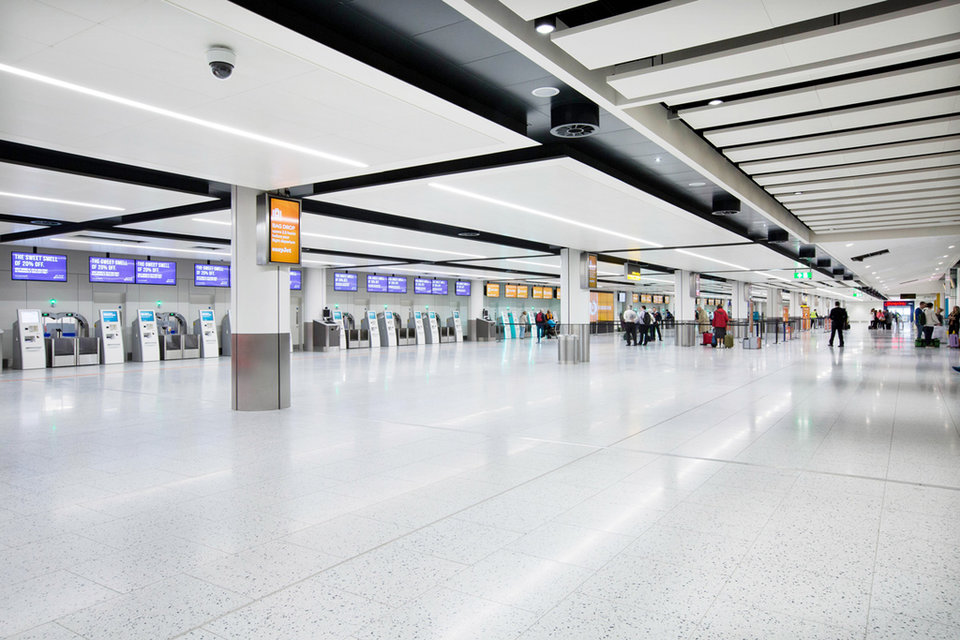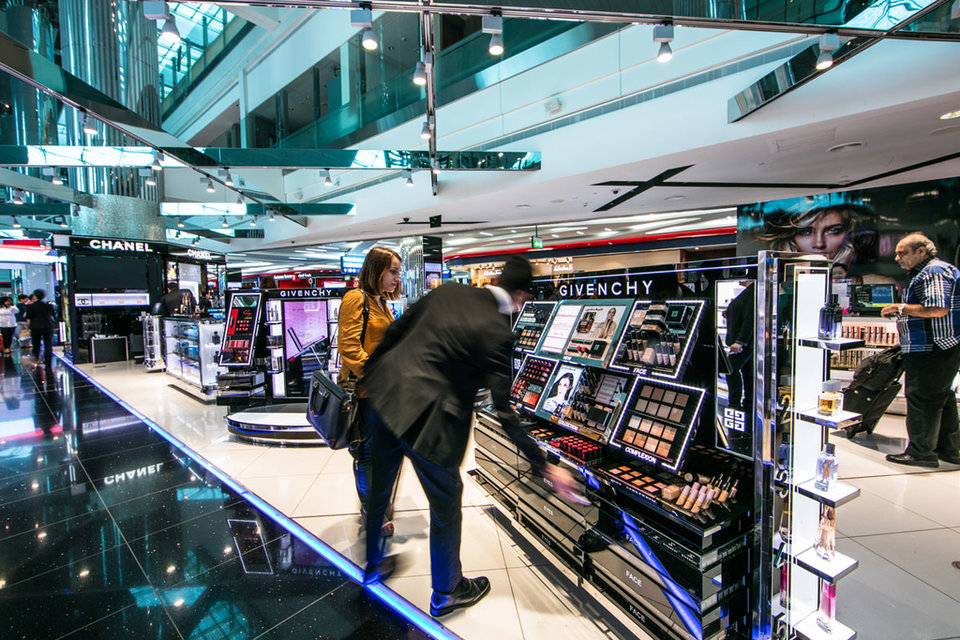Technology
creating a seamless airport experience after Covid-19
Airports want to deploy new technologies to make air travel seamless and stress free but the Covid-19 pandemic is making this much harder than usual. Senior writer Adele Berti looks back at her recent trip from London to Milan to assess how technology and coronavirus could change air travel in the years to come.
I recently went on a journey linking up three of Europe’s biggest airports, departing from London Heathrow, passing through Frankfurt Airport and arriving finally at Milan Malpensa. As an Italian working in London, it’s a trip I’ve done so many times that it had become normal and almost banal. Not anymore.
As I walked through the eerie corridors of Heathrow’s Terminal 2, all the way to its quiet departure lounge and empty bars and cafes, it was hard not to wonder what travelling will be like in ten or 20 years.
Ask any airport operator about their short and long-term goals and chances are that the words ‘stress-free’ or ‘seamless travel’ will come up in their answer. Yet while stress will always be an intrinsic part of air travel, the prospect of having a seamless journey through the airport is slowly becoming a reality.
Airports are heavily investing in new technologies and travel gadgets and passengers are always hungry for new projects that relieve the pressure of flying. But in a post-coronavirus world, new challenges will inevitably arise and trigger unprecedented changes to the entire airport experience.
Passengers like myself were only just starting to get used to the likes of artificial intelligence (AI) and miscellaneous robotics, and will now have to adjust to the requirements of the Covid-19 pandemic. With so many challenges to solve, just how different will airports be in the future?

Senior features writer, Adele Berti.
Image:
Preparing to fly: the age of facial recognition
As things stand now, information is arguably one of the top priorities for any traveller. Even before reaching the airport, receiving updates about anything from flight status to weather conditions and traffic is essential for many. Add in the mix the current coronavirus crisis, various social distancing measures and protective equipment requirements and you’ll need nearly encyclopedic knowledge before even leaving home.
While this information can currently be found on airlines and airports’ websites, email alerts or simply on Google, some aviation players are increasingly working to convey all details needed into one unique data provider - mobile phones. Preparing for my trip required a mix of these mediums. Heathrow’s website was the go-to place to prepare for the new health and safety requirements, while Lufthansa’s app was useful when checking on flight updates and for storing my digital boarding pass.

Smartphones could be key to improved information sharing at airports.
Recent trials suggest that phones could not only provide information but also become a digital wallet containing your documents, boarding pass and other types of cloud-based data. This is the concept behind the International Air Transport Association’s One ID, an integrated identity management solution that is laying the groundwork for the end of paper-based travel. Made possible by biometric technology, the idea is rapidly being branded as the future of air travel.
Reaching the airport will also get easier as time goes by. Train rides to the airports could be sped up by innovations in hyperloop technology, while airport parking lots will be increasingly filled with charging areas for electric cars.
While my ride to the airport was an Uber driver - who wasn’t impressed with my travelling companion’s three heavy bags - the past couple of years have also seen a rise in airport concierge services that pick up the luggage at home and deliver it to the airport. This so-called ‘Amazon model’ is gaining traction in various forms, ranging from car and train-based pick-ups to end-to-end deliveries. Finally, thanks to advancements in baggage monitoring technology, tracking apps and RFID tags, the likelihood of baggage getting lost or mishandled will lower exponentially in the next decades.
Departures: self-baggage drop and thermal cameras
Travelling in the age of coronavirus was certainly an unusual experience, though one that will probably become the norm in the years to come.
Because of the current crisis, people can’t sit next to one another and keep a safe distance. This is something that future airports will have to address as travelling becomes increasingly health and safety-conscious. But it probably won’t be too much of an issue - many hubs in Europe (Heathrow most of all) have been struggling with capacity for some time and have already been looking at ways to create or refurbish spaces in order to process more people. Any future modernisation plans will have to balance social distancing and the prospect of large crowds.

The self-service baggage drop zone at Gatwick Airport, UK. Image: Gatwick Airport
Another key area set for upgrades is baggage drop; at Heathrow’s T2 the process is still rather conventional, but self-drop baggage lanes have long been trialled at hubs like Gatwick and Stansted. When I last went to check for myself - during a press trip to Gatwick organised by easyJet - our guide said the technology cuts easyJet’s processing times to under five minutes.
As more airports are expected to adopt them in the next few years, there will also be scope to combine post-Covid-19 touch-free rules with new technology, so chances are that either a robot will help you check your luggage or AI-powered facial recognition machines will identify your face and travel details instantly.
Beyond baggage handling, technology will play a decisive role in airports’ need to minimise physical contact while supporting their customers. A recent example is John F. Kennedy’s newly introduced Google Assistant Interpreter Mode, which offers translations in 29 languages and - while sadly taking jobs away from skilled staff - it will be a game changer post-coronavirus.
Lastly, a relatively new entry for the industry will be thermal imaging cameras that scan passengers’ body temperatures as they reach the airport - something that Heathrow is currently pioneering in a hope to spot early cases of Covid-19. According to a recent webinar held by software developer Genetec, these machines will have to be paired up with passenger flow analytics and social distancing management software, allowing operators to identify areas that require intervention.
Security checks: fast processing and biometric surveillance cameras
Security will probably change the most in the years to come, and the industry is already showing eagerness to take on new technologies. Borders at Heathrow and in Frankfurt are still fairly standard. Some German airports are now using a new type of body scanner that takes seconds per person, but the drill is pretty much the same: everything from shoes to laptops, liquids and jewellery must be stowed in trays for scanning.
Over the last couple of years, I’ve attended enough airport expos and conferences to know that the age of removing items from the bag won’t last much longer. It will soon be replaced with scanners that can differentiate objects inside luggage from inside in much more detail. Whether it will be by using 3D imaging, X-ray or anomaly protection algorithms, airports are cruising towards the age of fast processing - and the pandemic is only likely to speed it up.

A millimetre wave scanner at Cologne Bonn Airport. Image: © Raimond Spekking / CC BY-SA 4.0 (via Wikimedia Commons)
As for body scanners and metal detectors, research teams all around the world are currently working to integrate them with AI and other new technologies. According to the International Civil Aviation Organization’s news website Uniting Aviation, AI-based automated target recognition algorithms fitted within existing millimetre wave scanners could eliminate passenger divestiture at screenings, and will be capable of differentiating between benign and harmful items.
Finally, let’s not forget the overwhelming role that facial recognition could assume in the years to come. Airport surveillance cameras in Japan and China are already being equipped with biometric and terahertz technology that scans crowds as they move through airports. If successful, they will be able to identify potentially hazardous or explosive materials long before the offender reaches airport security.
Departure lounges: digital entertainment and deliveries
Departure lounges are set for major renovations in the years to come. As the place where travellers spend most of their time at the airport, they already play a crucial role in helping boost passenger ratings and are increasingly becoming a centre of architectural beauty and entertainment. Airports are rapidly evolving from mere transit areas to being a city away from the city - much like in the case of Singapore’s Changi Jewel airport - and we should expect more hubs to follow this example.
Needless to say, my recent experience both at Heathrow and Frankfurt couldn’t have been further away from this concept. All but essential shops are closed, terminals are depressingly quiet and there isn’t much scope for entertainment. Yet once travel fully resumes and the industry bounces back from its current financial difficulties, investment will return to breathe new life into terminals.
Technology and personalisation will be key drivers of this change. Delta Airlines is currently trialling a Parallel Reality experience that allows different passengers to simultaneously see their own flight updates from one screen. In addition, robots, chatbots and similar machines will use facial recognition to provide tailored information to passengers about their gate and how to navigate the terminal. As recently seen in Thai shopping malls, robots will also be used to encourage people to wash and sanitise their hands, while information boards will become touch-free.
On the entertainment front, there will also be space for augmented reality and virtual reality-based gaming rooms, audiovisual and hologram initiatives.
But none of this will be possible if major reforms fail to take place in the restaurant and retail space. During my trip, only a handful of shops were open in London and Frankfurt, there were long queues and waiting times were three times as long. In a post-Covid-19 shopping environment, duty-free areas and restaurants will need to find a new way to serve their clientele.

Dubai Duty Free is set to introduce a concierge service for passengers. Image: Dubai Airports
Deliveries will be crucial to achieving this purpose. For example, travel retailer Dubai Duty Free recently announced plans to partially reopen its venue at Dubai airport, though with a twist: people will be invited to use its concierge service, which allows them to select a product and have it delivered to them for payment.
The company has also launched a click-and-collect facility that allows people to order items before they arrive at the airport. Outside of airports, a similar model is already well established in the dining sphere, so we shouldn’t be surprised if future airports will employ the likes of Just Eat and Deliveroo to deliver food orders around terminals.
Now that the crisis is slowly but steadily becoming less severe, it may not be much longer until travel resumes in a more mainstream way. And while my trip was certainly unique, it painted a vivid image of what airports need to do and how they need to change in the future to return to pre-crisis levels. Failure to do so will not only discourage people from flying as much as they used to, but also leave the airport industry far behind other sectors with regards to customer experience and digital innovation.